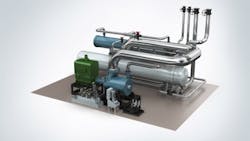Siemens Energy delivering High-Temp Heat Pump for Vattenfall district plant in Berlin
One key element of building electrification and next-gen energy efficiency works, required to bring down sizable greenhouse gas emissions, is innovating to create equipment to handle extreme climate events.
Those annual challenges include long, hard winters. Energy firms globally are striving to create a new generation of cold-climate and mass-volume heat pumps to handle cold fronts, heat waves and reduce build emissions.
European utility and power generater Vattenfall has contracted manufacturer Siemens Energy to demonstration a pilot project for a new large-scale, high-temperature heat pump in Berlin. The new equipment will be installed at the Potsdamer Platz to generate low-carbon district heating.
The project is known as Qwark3 (A German acronym for tri-coupling of district heating, power and cooling). Qwark3 is funded by the German Ministry of Economic Affairs and Energy as part of its long-running research and development efforts for carbon reduction.
Siemens Energy has designed the new high-temp heat pump to provide thermal capacity of up to 8 MW and deliver flow temperatures between 85 and 120 degrees Celsius (185 to 248 degrees Fahrenheit), depending on ambient conditions, the company says.
Vattenfall’s Berlin Potsdamer Platz plant has produced for about 12,000 offices, 1,000 housing units and numerous cultural facilities in the that part of the city. For decades the plant has generated additional unused waste heat which was dissipated into the surrounding air via cooling towers.
The partners believe that activating a new high-temp heat pump will provide a cleaner way of linking heating, cooling and electricity for the future. The technology makes waste heat usable and upgrades energy efficiency of the cooling power generation process.
Siemens predicts the new heat pumps and process will provide 55 GWh per year while saving some 6,500 metric tons of CO2 emissions and 120,000 cubic meters of cooling water, according to the release.
“Decarbonizing our heating supply is a key precondition for successfully achieving the objectives of the Paris Accords,” said Jochen Eickholt, Member of the Executive Board of Siemens Energy, when the project was announced earlier this year. “Large-scale heat pumps can play an important part in the medium to long-term conversion of our heating supply system. We’re very pleased to be working with Vattenfall to advance the heating transition in Berlin and trial this potentially key technology for the first time.”
The Siemens Energy heat pump will generate district heating using a combination of the waste heat and electricity from renewable energy resources, according to the release.
Vattenfall is also contracting with Siemens Enery to produce a gas-fired combined heat and power (CHP) plant in Marzahn. The 273-MW cogeneration facility will aid the power generator in closing down coal lignite-fired power and advancing toward its carbon-reduction goal of cutting 2 million tons of CO2 by 2030.
In the U.S., commercial buildings generate close to 800 million metric tons of CO2 annually. The federal Department of Energy is conducting a competitive Cold Climate Heat Pump Challenge for companies to innovate a new generation of that equipment.
So far, HVAC firm Lennox has apparently produced the first leap in the DOE Cold Climate Heat Pump Challenge. The Lennox prototype reportedly delivers 100 percent heating at 5 degrees Fahrenheit at double the efficiency of previous models. It also delivered 70-80 percent heating at minus 5 and minus 10 degrees.
-- -- --
(Rod Walton, senior editor for EnergyTech, is a 14-year veteran of covering the energy industry both as a newspaper and trade journalist. He can be reached at [email protected]).
About the Author
Rod Walton, EnergyTech Managing Editor
Managing Editor
For EnergyTech editorial inquiries, please contact Managing Editor Rod Walton at [email protected].
Rod Walton has spent 17 years covering the energy industry as a newspaper and trade journalist. He formerly was energy writer and business editor at the Tulsa World. Later, he spent six years covering the electricity power sector for Pennwell and Clarion Events. He joined Endeavor and EnergyTech in November 2021.
Walton earned his Bachelors degree in journalism from the University of Oklahoma. His career stops include the Moore American, Bartlesville Examiner-Enterprise, Wagoner Tribune and Tulsa World.
EnergyTech is focused on the mission critical and large-scale energy users and their sustainability and resiliency goals. These include the commercial and industrial sectors, as well as the military, universities, data centers and microgrids. The C&I sectors together account for close to 30 percent of greenhouse gas emissions in the U.S.
He was named Managing Editor for Microgrid Knowledge and EnergyTech starting July 1, 2023
Many large-scale energy users such as Fortune 500 companies, and mission-critical users such as military bases, universities, healthcare facilities, public safety and data centers, shifting their energy priorities to reach net-zero carbon goals within the coming decades. These include plans for renewable energy power purchase agreements, but also on-site resiliency projects such as microgrids, combined heat and power, rooftop solar, energy storage, digitalization and building efficiency upgrades.

